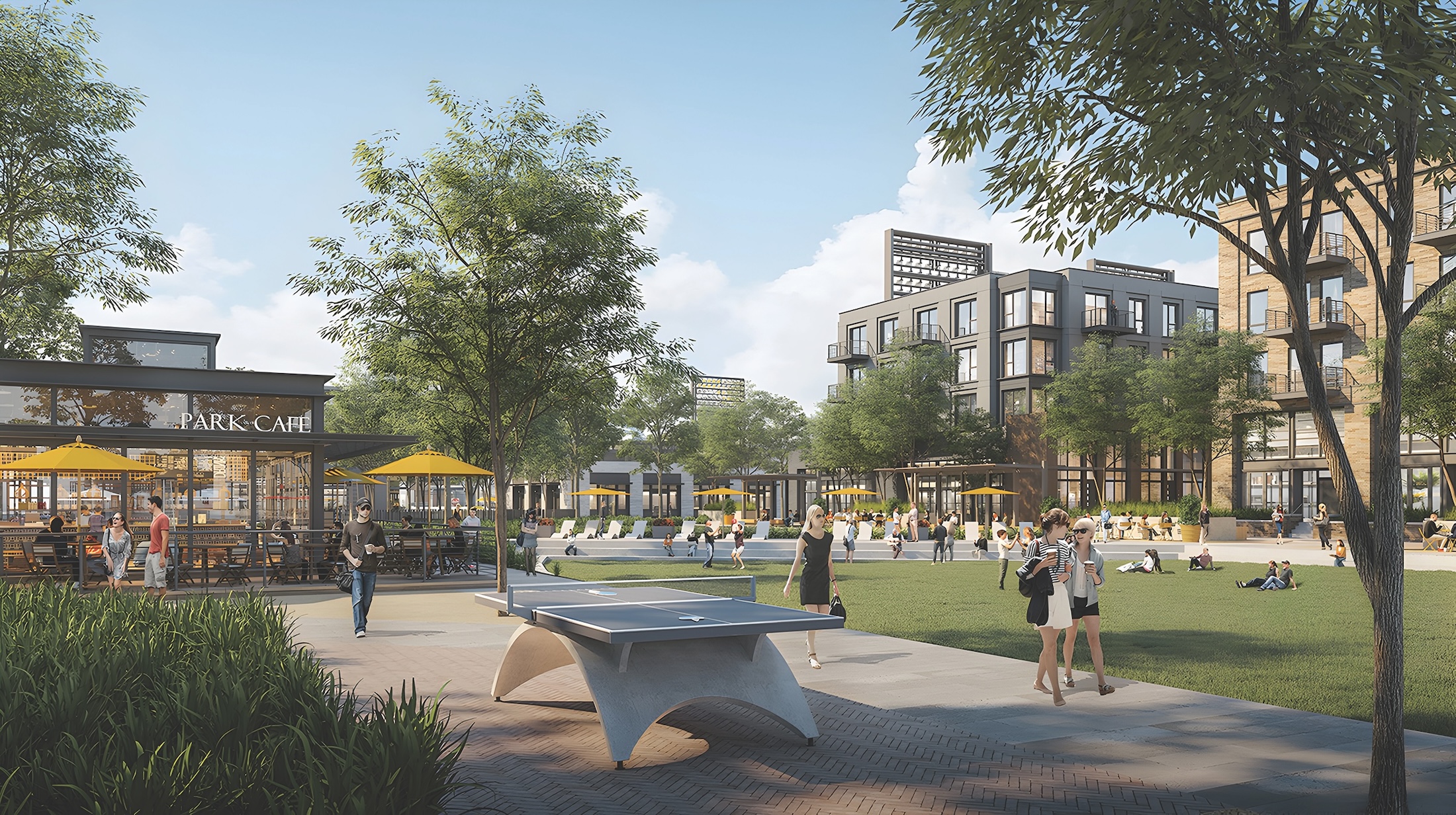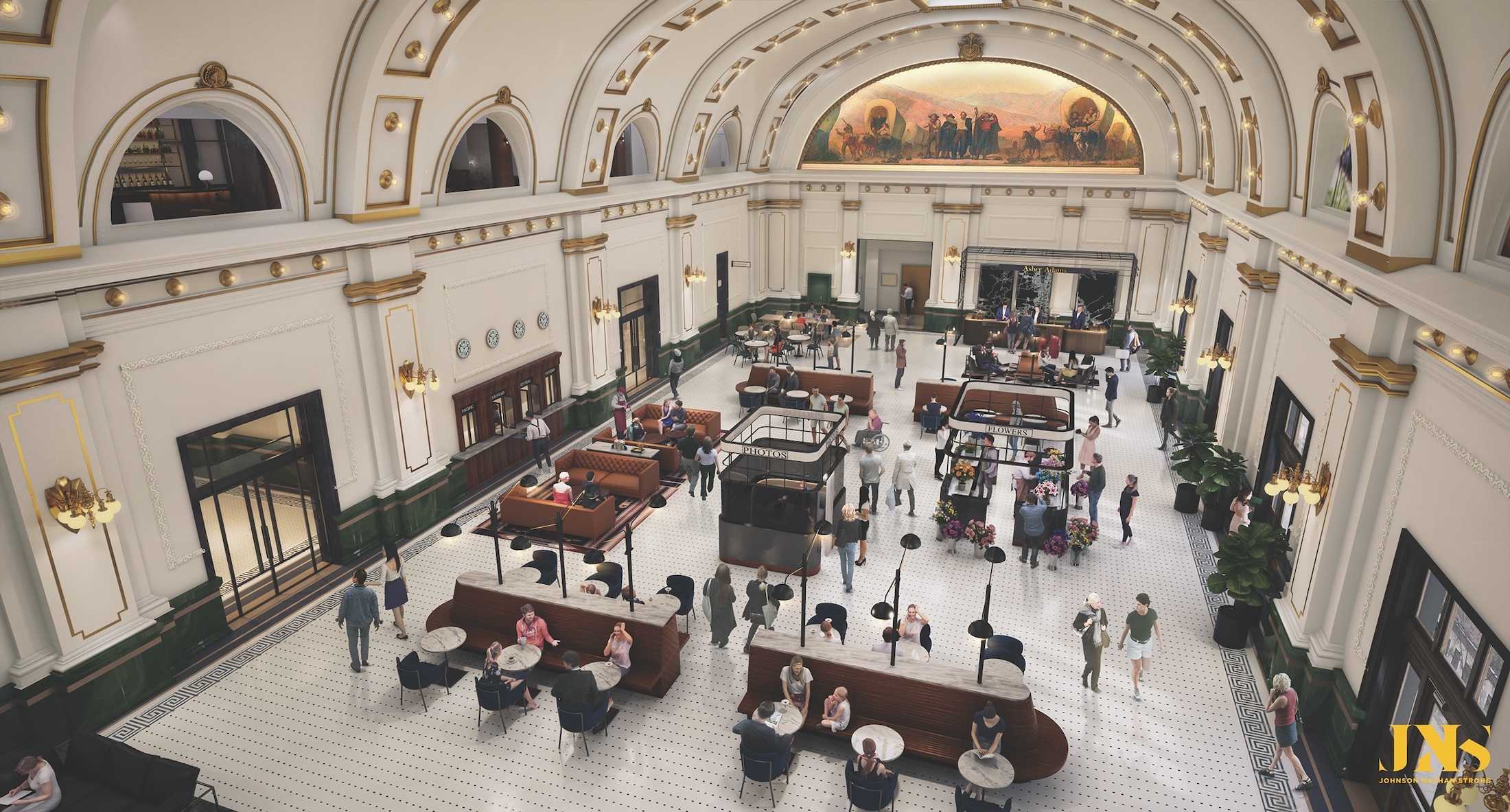Since its construction began two decades ago, Daybreak, the 4,100-acre master-planned community in South Jordan, Utah, has been a catalyst and model for regional growth. The community is now home to more than 30,000 residents living in 9,300-plus houses. Construction of another 10,000 houses is planned through 2036, over which period the community’s population is projected to increase to at least 50,000. The community is also projected to have more than nine million sf of leasable commercial space by 2036.
Daybreak continues to be a “release valve” for the entire Salt Lake Valley, said Brad Holmes, President of Larry H. Miller Real Estate, a development firm that, in April 2021, purchased 1,300 acres of undeveloped land within the community. Last October, the developer broke ground on the first phase of Downtown Daybreak, a 200-acre mixed-use entertainment district that will serve as a walkable and bikeable neighborhood within the community, anchored by a minor-league baseball park and a cinema/entertainment complex.
RELATED ARTICLES:
- 12 U.S. markets where entertainment districts are under consideration or construction
- Entertainment districts are no longer just about sports, dining, and music
For over two years, Larry H. Miller Real Estate worked with a design team that included MVE + Partners to create the master plan for Downtown Daybreak. Tim Beuchat, Sr., an Associate Partner at MVE + Partners, declined to comment further about the project except to say that his firm was in construction documents for the neighborhood’s first two mixed-use buildings that will encompass residential apartments, retail, and district parking structures. Stephen James, the developer’s Chief Visionary Officer, did not respond to questions sent by BD+C.
According to Downtown Daybreak’s website, the district’s first phase will include 75,000 sf of retail and food and beverage space, 100,000 sf of office space, more than 300 residential units, parks and outdoor recreation that includes an ice-skating rink, an outdoor amphitheater and stage, and a third light-rail station for the TRAX Red Line.

It appears that the housing being built for Downtown Daybreak will be mostly multifamily. One builder, Sego Homes, is promoting townhouses from its Sky Terrace Collection that range from 1,449 to 2,491 sf in size, and from $454,900 to $597,000 in price. Another builder, Holmes Homes, is offering nine floorplans from its Tempo Condominiums brand, ranging from $355,900 to $419,900 in price, and from 1,092 to 1,329 sf in size.
Sports and entertainment anchors
Currently, the Salt Lake Bees, a Triple-A baseball team affiliated with the Los Angeles Angels, plays at Smith’s Ballpark, a stadium with a 14,354-seat capacity. On opening day in 2025, the team—which Larry H. Miller Company owns—expects to move into its new home, a 7,500-seat ballpark in the heart of Downtown Daybreak. The privately funded stadium will offer a range of ticket options, from open-lawn seating to luxury boxes.
According to Ballparkdigest.com, the partners on the stadium’s construction, along with MVE + Partners and Larry H. Miller Real Estate, are Okland Construction, TallyCM, HOK, Urban Design Associates, Atlas Architects, and Loci Landscape Architects. America First Credit Union is Downtown Daybreak’s naming rights partner, and the downtown’s plaza will be called America First Square. (At presstime, the name of the stadium had not been disclosed.)
Downtown Daybreak’s other anchor, which Larry H. Miller Real Estate is building, is a megaplex entertainment center that will have between eight and 10 movie screens with luxury seating, 16 to 20 bowling lanes with lane-side dining, arcade games, a sports-themed lounge with access to an in-house chef and a scratch kitchen serving food made from fresh ingredients, and spaces for private dining, parties, and events.

Downtown Daybreak is projected to take 15 years to build out, with much of Phase 1 scheduled for completion next year. (The construction cost of this project has not been disclosed.) The district will be a 25-minute drive from Salt Lake City’s airport. It will also be near the University of Utah’s South Jordan Health Center, two other light-rail stations, two miles of Mountain View Corridor frontage, and 50-plus walking trails.
South Jordan’s Mayor, Dawn Ramsey, sees Downtown Daybreak as a “regional destination” with opportunities to create synergies. The new district “will rebalance the entire valley,” predicts Andrew Gruber, Executive Director of the Wasatch Front Regional Council, which 20-plus years ago came up with the idea for Daybreak with Envision Utah, a nonprofit business development advocacy organization.
Salt Lake City train station becomes a hotel
As Downtown Daybreak gets under way, downtown Salt Lake City is going through its own evolution.
Its new construction projects include the 225-key Asher Adams hotel, an adaptive reuse of the historic Union Pacific Depot Train Station. This Marriott Autograph Collection hotel, developed by the Athens Group and Hatteras Sky, topped off last October and is scheduled to open next fall. Okland Construction is the CM on this project, HKS Architects provided architectural design services, and JNS Design devised the hotel’s interior design. Pivot, a lifestyle operating vertical of Davidson Hospitality Group, will manage the hotel.

Utah Business reported that The Athens Group is converting the train depot into 13 historic guest suites, and constructing an entirely new building with 212 modern suites. The hotel will include a 1,500-sf fitness center, 9,000 sf of meeting space, and 3,200 sf of open-air gathering space.
The Asher Adams hotel, as completed, will be attached to The Depot, a 17,000-sf live entertainment and event venue that is also connected to the Delta Center arena, home to the Utah Jazz NBA franchise. The hotel will be located near the city’s Olympic Plaza on the northside of The Gateway, a popular open-air retail, residential, and office complex. The Gateway offers 650,000 sf of dining, entertainment, shopping, and special-events space. The Gateway first opened in November 2001, and since 2016 has been owned by Vestar, a Phoenix-based real estate developer that specializes in shopping centers.
On February 15, The Larry H. Miller Company said it would invest $3.5 billion into the Power District, a historical development in Salt Lake City. The company’s new renderings of this 100-acre project include images of a stadium (the Miller family has long expressed an interest in bringing major league baseball to Salt Lake City). The company is working with Sasaki on the Power District, according to the Salt Lake Tribune newspaper.
Related Stories
| Jun 3, 2013
Construction spending inches upward in April
The U.S. Census Bureau of the Department of Commerce announced today that construction spending during April 2013 was estimated at a seasonally adjusted annual rate of $860.8 billion, 0.4 percent above the revised March estimate of $857.7 billion.
| May 28, 2013
Minneapolis transit hub will double as cultural center [slideshow]
The Building Team for the Interchange project in downtown Minneapolis is employing the principles of "open transit" design to create a station that is one part transit, one part cultural icon.
| May 21, 2013
RSMeans cost comparisons: pools, racquetball courts, bowling alleys, hockey/soccer facilities
Construction market analysts from RSMeans offer construction costs per square foot for four building types across 25 metro markets.
| May 17, 2013
First look: HKS' multipurpose stadium for Minnesota Vikings
The Minnesota Sports Facilities Authority (MSFA), the Minnesota Vikings and HKS Sports & Entertainment Group have unveiled the design of the State’s new multi? purpose stadium in Minneapolis, a major milestone in getting the $975 million stadium built on time and on budget.
| May 16, 2013
Chicago unveils $1.1 billion plan for DePaul arena, Navy Pier upgrades
Hoping to send a loud message that Chicago is serious about luring tourism and entertainment spending, Mayor Rahm Emanuel has released details of two initiatives that have been developing for more than a year and that it says will mean $1.1 billion in investment in the McCormick Place and Navy Pier areas.
| Apr 30, 2013
Tips for designing with fire rated glass - AIA/CES course
Kate Steel of Steel Consulting Services offers tips and advice for choosing the correct code-compliant glazing product for every fire-rated application. This BD+C University class is worth 1.0 AIA LU/HSW.
| Apr 26, 2013
Solving the parking dilemma in U.S. cities
ArchDaily's Rory Stott yesterday posted an interesting exploration of progressive parking strategies being employed by cities and designers. The lack of curbside and lot parking exacerbates traffic congestion, discourages visitors, and leads to increased vehicles emissions.
| Apr 24, 2013
Los Angeles may add cool roofs to its building code
Los Angeles Mayor Antonio Villaraigosa wants cool roofs added to the city’s building code. He is also asking the Department of Water and Power (LADWP) to create incentives that make it financially attractive for homeowners to install cool roofs.
| Apr 17, 2013
First look: Renzo Piano's glass-domed motion pictures museum
The Academy of Motion Picture Arts and Sciences last week released preliminary plans for its $300 million Academy of Motion Picture Arts and Sciences museum in Los Angeles, designed by Renzo Piano and local architect Zoltan Pali.
| Apr 2, 2013
6 lobby design tips
If you do hotels, schools, student unions, office buildings, performing arts centers, transportation facilities, or any structure with a lobby, here are six principles from healthcare lobby design that make for happier users—and more satisfied owners.
















